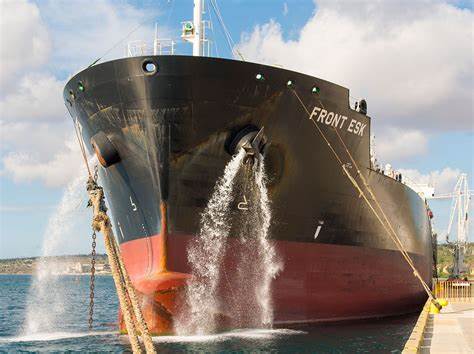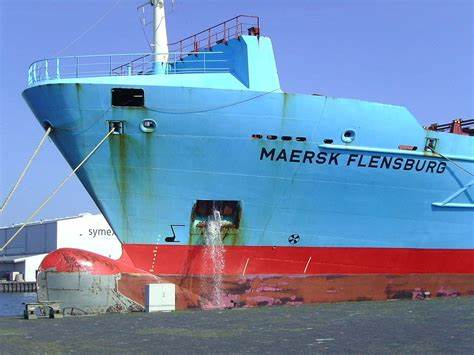Ballast water refers to water and suspended matter added to a ship to control its roll, trim, draft, stability or stress.
THE ROLE OF BALLAST WATER
1. Keep a certain depth of draft without capsizing when the ship is empty.
2. When the ship is carrying cargo, the ballast water can also be used to ballast and adjust between the ballast tanks to determine a certain draft difference or flat draft (the difference between front and rear draft is 0) to ensure smooth and safe navigation of the ship in specific waters.
3. The icebreaker uses high-power water pumps to quickly adjust the ballast water at both ends of the ship, so that the two ends of the ship can move high and low to cut off the ice on the sea and carry out ice-breaking operations, which is also the working principle of the icebreaker.

HAZARDS OF BALLAST WATER
Ship’s ballast water containing a large number of organisms, including plankton, microorganism, bacteria, and even small fish as well as a variety of species of eggs, larvae, or spore, some of these organisms in the process of following ship unable to adapt to the change of factors such as temperature, salinity and death, but some can survive, and eventually as the ship ballast water into the new environment. As a result, organisms or diverse groups of organisms from one water area are transported to another geographically isolated water area with ballast water. If these organisms are able to reproduce in natural or semi-natural ecosystems or habitats due to lack of natural enemies or other reasons,
Establishing populations can threaten the ecosystem structure and species diversity of these bays, estuaries or inland waters, becoming invasive species, and ballast water can spread harmful parasites and pathogens, and may even lead to the extinction of native species.
With the continuous expansion of the international shipping industry and the increasing awareness of Marine environmental protection, the invasion of alien Marine organisms caused by the discharge of ballast water from ships has attracted extensive attention from all walks of life. The global Environment Facility (GEF) has listed the trans-regional transfer of harmful aquatic organisms and pathogens in ballast water as one of the four major threats to the ocean.
SHIP BALLAST WATER TREATMENT METHOD
1.Row of shore method
It refers to the use of shore-based ballast water treatment device for ballast water treatment of ships. Shore-based equipment has fewer development restrictions and is easier to meet the CONVENTION’s D-2 standards. But it increases the burden of the port, for some ships with fast loading and unloading speed, may affect its shipping schedule.
2.Chemical treatment
Ozone (O3) treatment. Ozone is a strong oxidant with a REDOX potential of 2.07V, which is enough to kill invading microorganisms in ballast water, and there is no secondary pollution problem. But ozone will accelerate the corrosion of ballast tank, and the dosage is not easy to adjust, need a high technical level of management and maintenance, not adapt to the ship’s environmental space and technical force. Therefore, ozone method is not suitable for ballast water treatment on ships.
Chlorination process. Chlorination is feasible for ship ballast water treatment to remove phytoplankton and protozoa as well as bacteria, but the chlorine content is different for different target organisms. A small amount of chlorine has obvious effect on killing bacteria in ballast water. However, for plankplankton, due to its strong tolerance, a higher effective chlorine content is required for treatment. For example, for flat algae, the effective chlorine content is as high as 40mg/L in the chlorination treatment, but the purpose of removal still cannot be achieved.
Hydroxyl free method. Hydroxyl group has a strong oxidation capacity, which is similar to that of fluorine. The reaction is a free radical reaction with fast reaction speed, which can easily oxidize and decompose various organic and inorganic substances. The final product is CO2 and H2O, without residual pollution.
Electrolytic process. Electrolysis is a promising treatment technology for harmful aquatic organisms and pathogens in ballast water treatment, which can kill most of them under certain conditions. Electrolytic treatment of ballast water can affect the corrosion of metal in ballast tanks, and the corrosion rate varies with the change of available residual chlorine concentration and corrosion time.
Hydrogen peroxide. Its main advantage over other chemicals is that the residue is easily decomposed into water and oxygen, so it is environmentally sound. Its main disadvantage is that when there is too much organic matter in the ballast water, the effect will be reduced due to the oxidation of organic matter.
3.Physical cleanup
Ultraviolet radiation. Studies show that the ultraviolet treatment device is very effective in killing Marine bacteria and microorganisms. But the effect on killing alien harmful aquatic organisms may not be very good. Therefore, in the use of uv treatment devices, but also to consider how to kill foreign harmful aquatic organisms.
Heat treatment. According to the current research, the temperature is 38℃ ~ 50℃, and the heating lasts for 2 ~ 4h, which can kill most of the organisms, and there are difficult problems such as long processing time, high energy consumption, and thermal stress affecting the navigation safety of ships.
Ultrasonic method. It can produce heat and pressure wave deviation in the process of ship ballast water treatment, forming a semi-vacuum deoxygenation and resulting in the death of plankton. But there may be some currently unknown health issues. Cavitation can also damage the surface or structure of the water tank.
4.Generally clear
Dilution method. Refers to the pumping of seawater from the top of the ballast tank when the ballast water is changed at sea and the pumping of water from the bottom of the ballast tank at the same rate. This method is safer for ship water treatment than drainage and overflow method. Thus, the ballast water is pumped in and out at the same rate, essentially maintaining the same level in the ballast tank.
The emptying method. It refers to the vessel at sea when the ballast water replacement ballast water will be emptied until the pump suction loss. A small amount of seawater is then flushed and the ballast water is reloaded. The drainage method can effectively remove aquatic organisms and pathogens in sediments and silt on the surface of ship components in bilges and ballast tanks, but requires less water and short replacement time.
The overflow. It refers to the method of pumping clean seawater from the bottom of the ballast tank in ballast water treatment, so that the original ballast water is discharged from the top through the overflow hole. The replacement of ballast water by overflow method will not have a significant impact on the stability, draft and other factors of the ship, nor will it produce excessive shear stress and bending moment, but the replacement method needs to pump three times the capacity of seawater into the cabin, which takes a long time and consumes more energy.

BALLAST WATER TREATMENT SYSTEM
1.Role and task of ballast water system
Ballast water system’s function is to ballast water into water ballast tank or the water ballast tank discharge of ship ballast water so as to achieve the following purposes in sailing, shuangliu, loading and unloading and anchor maintains appropriate displacement, different working conditions, such draft, hull longitudinal and transverse balance in order to maintain the proper metacentric height decreases hull excessive bending moment and shear force to reduce the vibration of the hull.
The task of the ballast water system is to inject the ballast water into the ballast tanks through the ballast pumps, valve boxes and ballast lines, discharge the ballast water from the ballast tanks and transfer the ballast water between the tanks.
2.Requirements for ballast lines
(1)The flow of ballast water in the pipeline is “in and out”, that is to enter the ballast tank and self-ballast tank drainage through the same ballast pipeline. Therefore, check valve can not be set in the pipeline, but must be allocated through the globe valve box.
(2)In large ships, ballast pipes are laid in the pipe lane in the double bottom tank to prevent ballast water from entering the cargo hold. The arrangement of suction ports in each tank shall facilitate the discharge of ballast water.
The ballast piping of fore and aft peak tanks should be provided with gate valves that can be opened and closed on the upper deck when passing through the fore and aft bulkheads so as to close the gate valves immediately when the hull is damaged fore and aft to prevent the water from entering the ballast water system.

BALLAST WATER CONVENTION
The International Ballast Water Management Conference held by the International Maritime Organization in 2004 adopted the Convention on International Ballast Water and Its Sediment Control and Management, hereinafter referred to as the Ballast Water Convention, in which the entry into force of the Convention is stipulated 12 months after the ratification of 30 countries accounting for 35% of the world’s merchant shipping tonnage.
